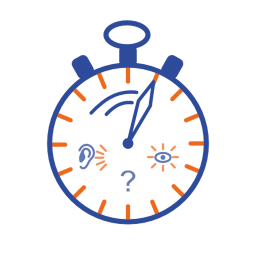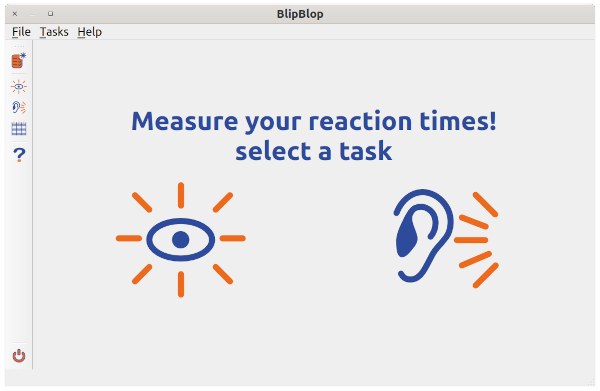2.1 KiB
BlipBlop
BlipBlop is a tiny tool for measuring reaction times upon auditory or visual stimulation. This tool is open-source. The source code can be found on GitHub. It is published under the MIT open source license. Auditory stimuli have been taken from the freedesktop system sounds.
Main Window
By pressing one of the big icons in the center of the screen you can start an experiment of measuring the visual or auditory reaction times. These functions are also available via the Tasks menu on top or the buttons in the tool bar (left). Once an experiment has been successfully performed the results can be viewed using the results screen (table icon on the left, or entry in the Tasks menu). You can make several experiments and all results will be stored unless you start a new session (top button in the tool bar or new session entry in the Tasks menu) or end the program.
The basic handling is very simple:
- Select a task.
- Press enter or return when ready.
- Fixate the cross in the center of the screen.
- After a countdown and a stimulus will be shown, or played.
- Press the spacebar as soon as you recognize the stimulus.
- By default 5 trials are recorded and the program returns to the main screen once the trials are done. You can press the esc key to abort an experiment. All data recorded in that task are discarded.
Follow the links in the text above for more information on the individual screens.
Hints & Ideas
- Record enough data. You will notice that the reaction times may vary a lot. In order to do proper analyses record enough data.
- Play with the stimulus saliency (size or opacity of the visual stimulus or volume, sound of the auditory stimulus).
- Auditory stimuli: compare the performance when closing the eyes or keeping them open.
- Visual stimuli: do not fixate on the central cross but maybe a spot outside the screen that has the disk appear in the visual periphery.

